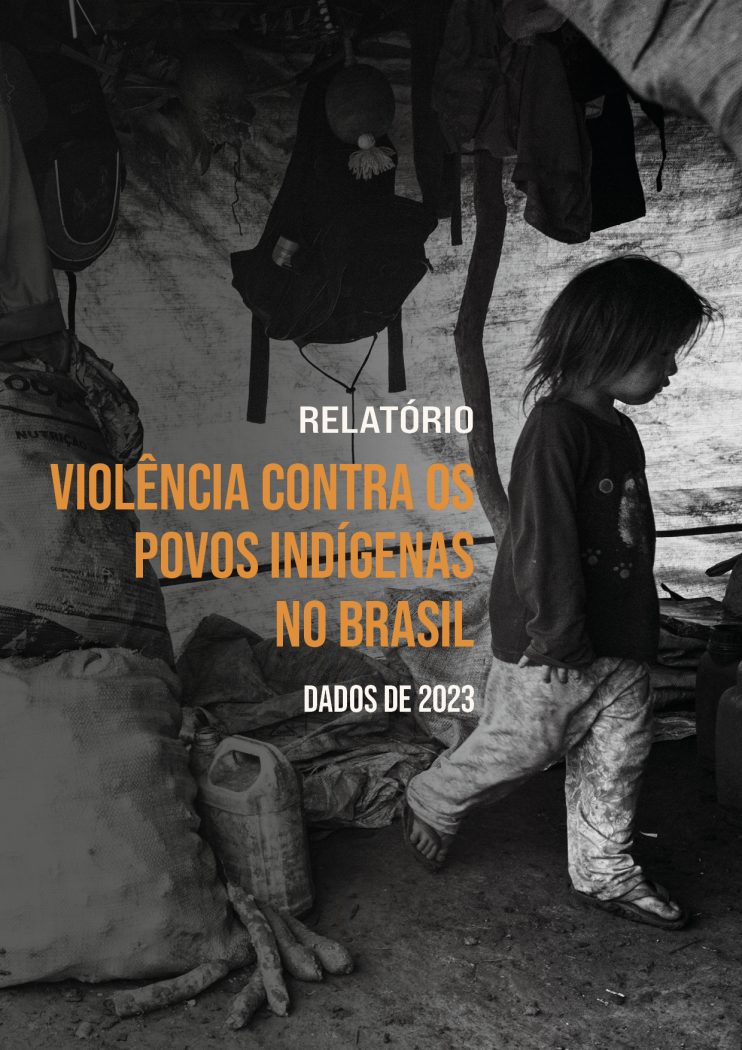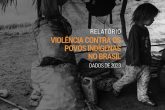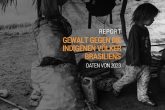Violence against Indigenous Peoples persisted in 2023, a year marked by attacks on rights and few advances in the demarcation of lands
Cimi’s annual report on violence against Indigenous Peoples presents data from the first year of Lula’s third term, marked by contradiction in indigenist policy
The disputes surrounding the Indigenous Peoples’ rights in Brazil’s three spheres of power resulted in the continuity of violence and violations against the native people and their territories in 2023. The first year of the new federal government was characterized by the reinstatement of monitoring actions and suppression of invaders in some Indigenous territories, but the demarcation of lands, protection actions and community assistance remained insufficient. Throughout several regions, the institutional environment of attacks on the Indigenous Peoples’ rights reverberated in the continuity of invasions, conflicts and violence against the indigenous communities, and the maintaining of high numbers of assassinations, suicides, and child mortality among the native people. Such is the conclusions of the Report on Violence Against Indigenous Peoples in Brazil – data from 2023, annually edited by the Indigenist Missionary Council – Cimi.
The year 2023 began with high expectations regarding the Indigenist Policy of the third term in office of President Luiz Inácio Lula da Silva. Not only did it come after an openly aggressive administration against Indigenous Peoples, but the subject was central in the speeches and statements made by Lula during the electoral campaign.
All of such legal landscape reflected upon a year with few advances in the demarcation of Indigenous Lands, the continuity of the invasion, the damage to Indigenous heritage, and conflicts related to territorial rights
This change was made symbolic by the presence of Chief Raoni, famed Kayapó leader, at the presidential inauguration. The unprecedented creation of a Ministry of Indigenous Peoples, and the nomination of Indigenous leaders to run the Ministry, the National Foundation for Indigenous Peoples – Funai, and the Secretariat for Indigenous Peoples’ Health (Sesai), added to the air of renewed hope.
At the beginning of the year, the conditions of the Yanomami People – denounced many times for a long period – caused worldwide commotion. After years of abandonment and active omission by the previous government in front of the illegal presence of gold miners in the Indigenous Land, the people were in extreme vulnerability. A state of National Health Emergency was declared, and a big operation on the territory started, pointing toward effective change in regard to the care of the Indigenous Peoples by the state.
Soon, however, the political reality imposed itself upon the government. The Congress acted to weaken the Ministry of Indigenous Peoples, and toward dismantling Indigenous Peoples’ rights – namely by the approval of Project of Law 490/2007, birthing the Law 14.701/2023 by the end of the year. The Legislative acted in clear contraposition to the Brazílian Supreme Court (STF), which had concluded, after years of deliberation, the trial of the special case which regarded the demarcation of Indigenous Lands – with a favourable decision to the Indigenous Peoples claims.
The Supreme Court recognized the Indigenous Peoples’ rights as “stone cluases” of the Federal Constitution, meaning they cannot be altered or restricted, and considered the temporal mark thesis to be unconstitutional. The thesis, which has haunted the native peoples for years, aimed to establish that only those territories under the possession of Indigenous communities during the date of the promulgation of the Constitution – October 5th, 1988 – could be recognized and demarcated as Indigenous Lands.
Despite the trial, the Congress included the temporal mark in Law 14.701 as a criterium to the recognition of new Indigenous Lands, as well as a myriad of legal instruments which, in practice, aimed to make new Indigenous Lands impossible to constitute and to open recognized lands to economical exploitation. The partial veto on the Law by President Lula was eventually overruled by Congress, with an extensive number of votes from parties which hold positions in office, and the Law came into force by the end of the year.
All of such legal landscape reflected upon a year with few advances in the demarcation of Indigenous Lands, the continuity of the invasion, the damage to Indigenous heritage, and conflicts related to territorial rights.
Though some protection operations were constituted, none had the initial power of that in the Yanonami territory, and even that one lost its momentum without fully dismantling the gold mining operations. In 2023, 276 cases of illegal exploitation of natural resources and miscellaneous damage to property were registered, spanning at least 202 Indigenous Territories in 22 of the Brazilian states.
Eight Indigenous Lands were homologated during the first year of the new administration, a number below expectations, even if higher than those of the last few years. The scarce advances in demarcation resulted in the intensification of existing conflicts, with several cases of intimidation, threats and violent attacks against Indigenous People, especially in the states of Bahia, Mato Grosso do Sul and Paraná.
The governmental interest in drilling oil by the outfall region of the Amazonas, the budget priority given to agrobusiness and the support of big infrastructure and mining projects in conflict with Indigenous Peoples, such those of the ‘Ferrogrão’ railway, and the mining in the Mura people’s territory in the Amazon, compounded the scenery of dashed hopes.
The sluggish demeanour, without a clear indication from the federal government of its commitment to protecting Indigenous Lands, influenced directly in the high countings of registered conflicts, many of them including cases of intimidation, threats and violent attacks against Indigenous Communities
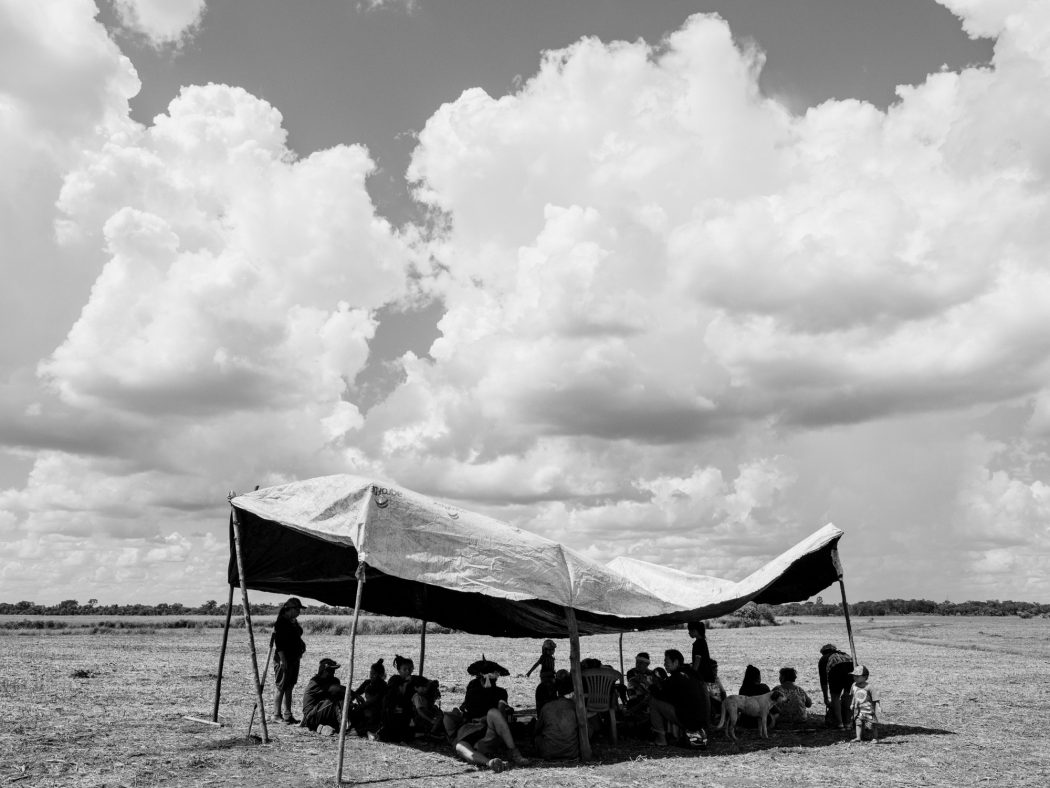
Tent under the Sun in the Guarani Kaiowá retaken land of Tekoha Laranjeira Nhanderu, Rio Brilhante (MS). March, 2023. Photo: Renaud Philippe/Retomada da Terra
Violence against Indigenous Heritage
The Report’s first chapter gathers all the cases of violence against Indigenous Peoples’ heritage, with a total of 1,276 registered cases. They are divided into three categories: omission and delays in the recognition of Indigenous Lands, with 850 cases; territorial rights-related conflicts, with 150 mentions; and illegal exploitation of natural resources and miscellaneous damage to property, with 276 cases.
The cases under the labels of territorial conflicts and invasions of Indigenous Lands maintained high numbers, although with a slight reduction relative to previous years. On one hand, the data reflect the reinstatement of monitoring operations; on the other hand, most of the reports point toward the continuity of the invasions and the lack of a permanent policy for protecting Indigenous Territories.
Among the main types of damage to the Indigenous heritage remains, as was in the last few years, reports of deforestation, extraction of natural resources such as illegal logging, hunting and fishing, and possessory invasions tied to land-grabbing.
Federal operations of removal of the invaders were concentrated on a small group of territories, especially the seven Indigenous Lands which were covered by a Supreme Court’s ruling (ADPF 709). Even in those instances, however, the reports indicate that such actions did not fully remove all invaders and that the operations do not have plans or actions to prevent the return of those invading campaigns.
From a total of 1,381 territorial demands that exist today in Brazil, the majority (62%) remain with administrative pendencies for their recognition processes, as the updated data from Cimi show. There are 850 Indigenous Lands with pending procedures, today. Among those, 563 still haven’t seen even the start of the procedures of recognition and demarcation.
In 2023, the biggest advances in territorial recognition were the constitution and reinstatement of Technical Groups (GTs) for the identification and delimitation of new Indigenous Lands, under the responsibility of Funai. It indicates the disposition of the agency to advance in the first step of the recognition procedure, which has been paralyzed for years until now. Nonetheless, progress is slow: only three Identification and Delimitation Reports were concluded and presented by Funai during the year.
The lack of definition of the temporal mark makes any prediction about the deadlines of such procedures impossible, as the government hesitates and uses Law 14.701/2023 to justify its delay in advancing in the matter. There was, for instance, no Declaration of Indigenous Lands by the Ministry of Justice, the next step of the recognition procedure.
The sluggish demeanour, without a clear indication from the federal government of its commitment to protecting Indigenous Lands, influenced directly in the high countings of registered conflicts, many of them including cases of intimidation, threats and violent attacks against Indigenous Communities, as happened in the states of Bahia, Mato Grosso do Sul, Paraná and others.
Just as it was in the previous years, the states of Roraima, Mato Grosso do Sul and Amazonas were the higher ranking in assassinations, with 47, 43 and 36 cases, respectively
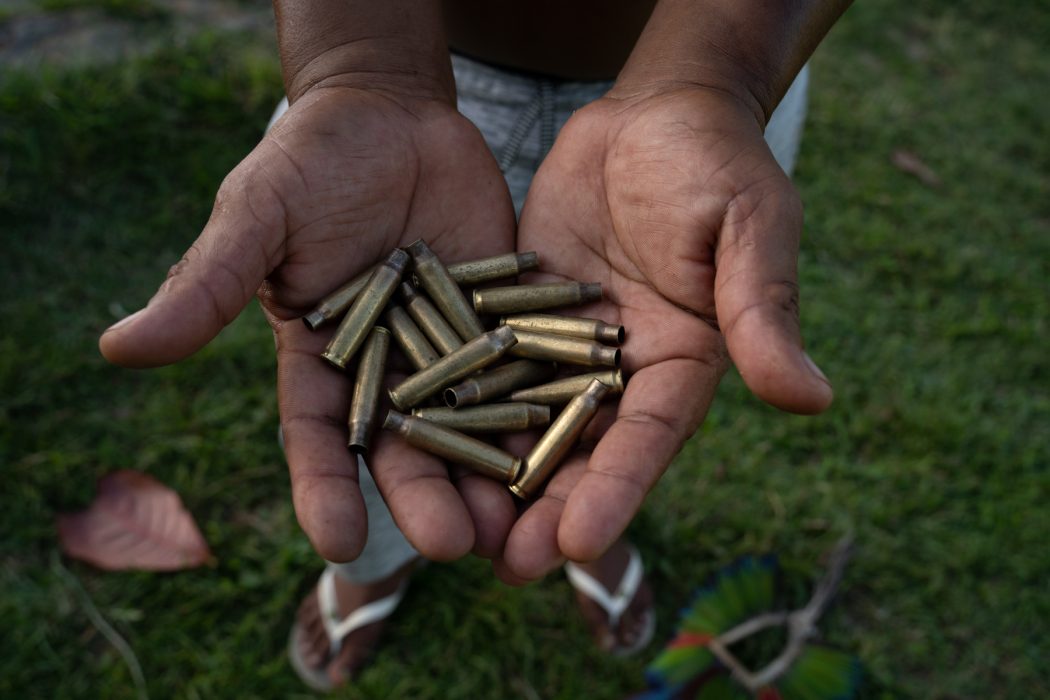
Bullet shells gathered by the Pataxó in the retaken land in the Indigenous Land Barra Velha do Monte Pascoal, in the state of Bahia, where two young men were assassinated. January, 2023. Photo: Tiago Miotto/Cimi
Violence against the Person
The cases of Violence against the Person, organized in the second chapter, summed up 411 registers in 2023. This section of the Report divides such cases into nine categories: abuse of power (15 cases); death threats (17); other threats (40); assassinations (208); wrongful deaths (17); aggravated assault (18); racism and discrimination (38); attempted murder (35); and sexual violence (23).
Just as it was in the previous years, the states of Roraima, Mato Grosso do Sul, and Amazonas were the higher ranking in assassinations, with 47, 43 and 36 cases, respectively. The data, summing up to 208, were compiled through the System for the Monitoring of Mortality (SIM), obtained from Sesai through the Brazilian Law for the Access of Information (LAI).
The assassinations by gunfire, in January, of young Pataxó Samuel Cristiano do Amor Divino, 23, and Nauí Pataxó, 16, in southern Bahia, stand out. They lived in a retaken part of the Indigenous Land Barra Velha do Monte Pascoal and were executed when they went out to buy food and supplies in the surrounding area.
The Pataxó have been fighting for years for the demarcation of their lands in the region. The conflicts they face remained without resolution throughout 2023, due to the lack of advances in the territorial recognition procedures, and motivated precautionary measures issued by the Inter-American Commission on Human Rights.
The involvement of military policemen with the private militias under investigation for the deaths shares similarities with the violence cases registered against indigenous peoples in Mato Grosso do Sul, where police forces are being accused of acting as private security for farmers, sharing intel and supporting attacks from sicarios against Guarani Kaiowá communities. In the region, alongside the violent attacks against camped Indigenous communities, arbitrary detention and illegal evictions were registered.
Violent attacks from gold miners kept being reported throughout 2023, despite the operations that happened in the first semester in Yanomami Lands. Murders, armed raids, sexual assaults and recruitment for gold mining, alongside internal conflict, formed the tragic frames of the continued violence in the territory.
Assassinations of indigenous leaders of the Guajajara People in Maranhão remained numerous, especially in the Arariboia Indigenous Land, which has been dilapidated for many years by invaders. The cases of armed violence against the Tembé and Turiwara, in northeastern Pará, situated in the context of conflicts with big corporations linked to palm oil farming and production, also continued.
Lack of basic sanitation and drinking water are aggravated by the climate crisis, which caused floods countrywide, and a severe drought in the Amazon region, putting several communities in a state of severe vulnerability
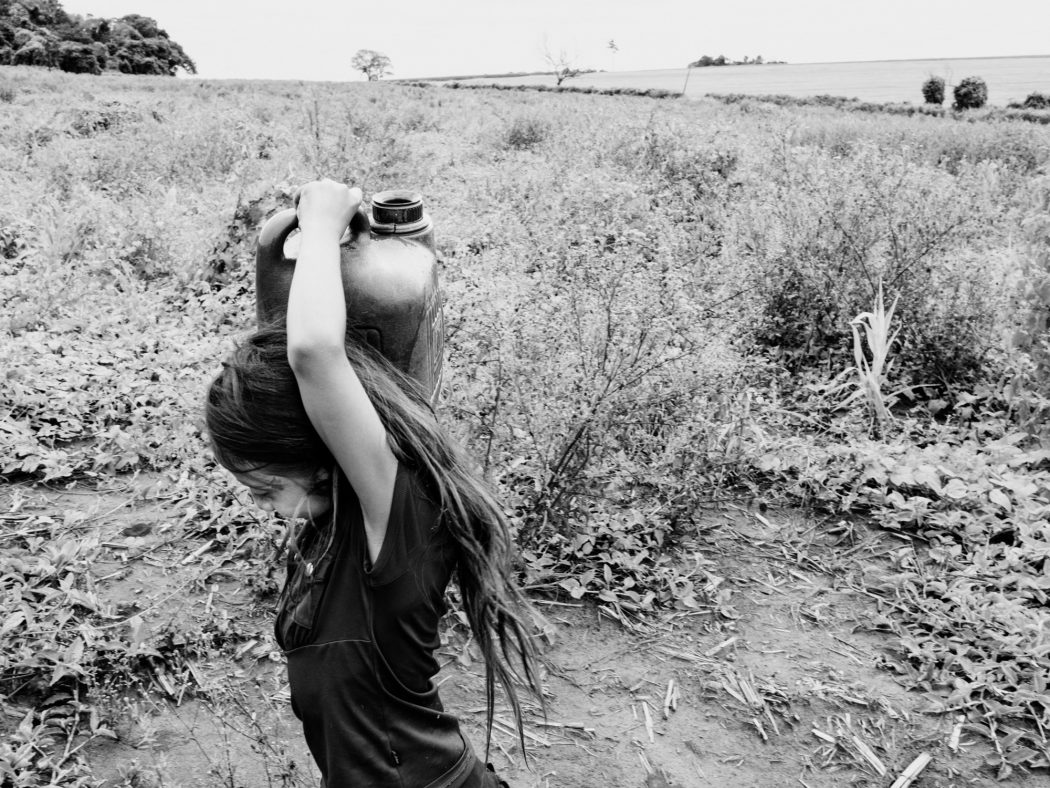
In the municipality of Amambai (MS), in the retaken land of Guapo’y Mirin Tujury, a Guarani Kaiowá girl carries the water she got from the river, over half an hour’s walk away. The river sits at the frontiers between the retaken indigenous land and a soy farm which contaminates the water with pesticides.. Photo: Renaud Philippe/Retomada da Terra
Violence by Omission from the State
The third chapter of the Report gathers the cases of Violence by omission of the State and organises them into seven categories. Data from the System for the Monitoring of Mortality reveal 1040 deaths of Indigenous children aged 0 to 4 in 2023. Also in this case, the same states from previous years concentrated the higher numbers of occurrences: Amazonas, with 295 deaths; Roraima, with 179, and Mato Grosso with 124.
The greatest part of the child mortality happened by causes considered as avoidable through healthcare, immunization, diagnosis and adequate treatment. Among such causes, stand out the mortality of the flu and pneumonia, in 141 cases; diarrhea, gastroenteritis and other intestinal illnesses (88 cases); and malnutrition, in 57 cases.
Information from the same public databases indicates the occurrence of at least 180 suicides among Indigenous Peoples in 2023. The higher numbers, as in previous years, were registered in Amazonas (66), Mato Grosso do Sul (37), and Roraima (19).
The third chapter registers also the following data for the year 2023: general lack of assistance (66 cases); lack of assistance in Education (61); lack of assistance in Health (100 cases); dissemination of alcoholic beverages and other drugs (6); and death by lack of healthcare (111 cases). A total of 344 cases.
Standing out in these categories is the general lack of school infrastructure in Indigenous villages and communities all over the country; and the lack of infrastructure, human resources and transportation means in the healthcare of Indigenous Peoples. Lack of basic sanitation and drinking water are aggravated by the climate crisis, which caused floods countrywide, and a severe drought in the Amazon region, putting several communities in a state of severe vulnerability.
It is in due order to mention that the Report started this year monitoring the cases of deaths by lack of assistance in healthcare with the data from the System for the Monitoring of Mortality, which explains the higher number of cases relative to the previous years.
The new administration renewed the restriction ordinances the previous administration had left to expire. However, the situation is still dire, because the majority of the Indigenous Lands with the presence of isolated groups that were subject to invasions in the previous years kept registering invasions in 2023

Signpost of invaders in the Karipuna Indigenous Land, where there are isolated Indigenous groups, reads: “Please, do not touch my timber”. November, 2023. Photo: Maiara Dourado/Cimi
Indigenous Peoples in Isolation
The fourth chapter of the Report is dedicated to analysing the conditions of Indigenous Peoples in Voluntary Isolation. Those groups, amongst the most affected by the deconstruction of the policies for monitoring and protecting Indigenous Lands in the last years, remained under severe threat in 2023.
The new administration renewed the restriction ordinances the previous administration had left to expire. However, the situation is still dire, because the majority of the Indigenous Lands with the presence of isolated groups that were subject to invasions in the previous years kept registering invasions in 2023. At least 56 from a total of 119 references of isolated groups registered by Cimi are located in Indigenous Lands that suffered from invasions in 2023.
Other than the renewed ordinances, there were no actions by the federal government to guarantee the protection of isolated groups localised outside Indigenous Lands that are currently recognised: those correspond to 37 of the 119 references. Some of such cases are even recognised by Funai, as the isolated group in Mamoriá Grande, in Lábrea (AM).
In these territories, despite some robust actions against the invaders, as was the case for the Indigenous Land Ituna/Itatá, in Pará, most of the operations were insufficient to guarantee the effective protection of the area. Indigenous Leaders from Lands such as Vale do Javari, in the state of Amazonas, e Karipuna, in Rondônia, reported the continuous presence of invaders.

Third March of the Indigenous Women, in Brasília. September, 2023. Foto: Maiara Dourado/Cimi
Memory
The fifth chapter brings forth a discussion of Memory and Justice in two articles for the current edition. The first article is a study by late researcher Marcelo Zelic (1963-2023) regarding the history of Indigenous Land Ananás, in Roraima. It presents propositions for the reparation of the damage caused to the Macuxi and Wapichana Indigenous Peoples by the so-called ‘tutelage crimes’: violations committed by the State during the Brazilian Dictatorship using the legal instrument of tutelage to derail their political movements and take their lands. The text was edited by researchers and relatives, who which to maintain Zelic’s legacy to the theme of Memory and the fight for the creation of mechanisms of non-repetition of acts of violence committed against Indigenous Peoples.
In the second article, one of Cimi’s founding members, Egydio Schwade makes a retrospective analysis on the first of Cimi’s instruments to report violence against Indigenous Peoples. Published first fifty years ago in 1974, the study Y-Juca Pirama – o índio: aquele que deve morrer [[1] ‘Y-Juca Pirama – the indian: he who is supposed to die’] was the predecessor of the present Report.
Articles and Analysis
Besides the chapters of the Report which organize the data, the Report for 2023 gathers as well articles that aim to deepen the understanding of the current situation. The condition of incarcerated Indigenous Peoples in Brazil, and the meaning of physical and symbolic violence of the arson of Praying Houses Guarani Kaiowá are topics detailed in two of the articles this time. Further, we present a detailed analysis of the racism and discrimination cases against Indigenous Peoples and an assessment of the budgetary challenges to the Indigenous Policies in 2023.

Caci
The Caci platform consists of a digital map that presents the information about assassinations of Indigenous People in Brazil. It is updated with data from the Report for 2023. The acronym for Cartography of Attacks against Indigenous (in Portuguese), also forms the word for ‘ache’ in Guarani. With the inclusion of the data for 2023, the platform now contains information on 1,470 cases of murders of Indigenous Peoples, compiling data since 1985.
Further information in em caci.cimi.org.br
Executive summary translated from Portuguese to English by Christian Crevels.
The Report Violence Against Indigenous Peoples in Brazil is an annual edition from the Indigenist Missionary Council – Cimi, an organization linked to the National Conference of the Bishops of Brazil – CNBB. Founded in 1972, Cimi has been active for 52 years in the defense of Indigenous Peoples’ cause.
Front cover: art from Verônica Holanda
Front cover image: retaken land of Guapo’y Mirin Tujury, in the municipality of Amambai (MS), February 2023. Laisquene, Guarani Kaiowá girl three years old, is inside the plastic canvas tent in which she lives with her parents. In the previous year, leaders from that Tekoha, the land, were murdered. The Image was taken by Renaud Philippe and is part of the project Retomada da Terra, by Renaud Philippe and Carol Mira, as well as other images from the series that illustrate the present edition. More at renaudphilippe.com

